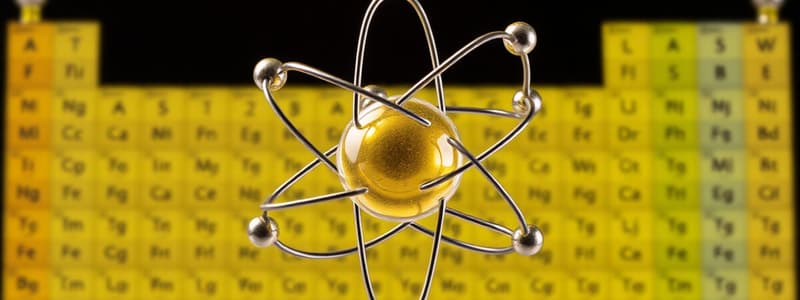Podcast
Questions and Answers
What is stoichiometry primarily concerned with?
What is stoichiometry primarily concerned with?
- The calculation of reactants and products in chemical reactions (correct)
- The study of organic compounds and their functions
- The determination of solvent properties
- The measurement of temperature in reactions
What is defined as a homogeneous mixture of solute and solvent?
What is defined as a homogeneous mixture of solute and solvent?
- Colloid
- Suspension
- Emulsion
- Solution (correct)
In chemistry, what does the term 'concentration' refer to?
In chemistry, what does the term 'concentration' refer to?
- The temperature at which a reaction occurs
- The total mass of all reactants
- The volume of a solvent in a reaction
- The measure of the amount of solute in a given volume of solution (correct)
What are hydrocarbons primarily composed of?
What are hydrocarbons primarily composed of?
Which of the following are functional groups in organic chemistry?
Which of the following are functional groups in organic chemistry?
Which state of matter has a fixed shape and volume?
Which state of matter has a fixed shape and volume?
What is the charge of protons in an atom?
What is the charge of protons in an atom?
In which part of the Periodic Table are elements with similar properties found?
In which part of the Periodic Table are elements with similar properties found?
What type of bond is formed through the sharing of electrons?
What type of bond is formed through the sharing of electrons?
What are the substances called that undergo change in a chemical reaction?
What are the substances called that undergo change in a chemical reaction?
Which substance donates protons (H+) in a solution?
Which substance donates protons (H+) in a solution?
Endothermic reactions are characterized by which of the following?
Endothermic reactions are characterized by which of the following?
What is the value of one mole in terms of particles?
What is the value of one mole in terms of particles?
Flashcards are hidden until you start studying
Study Notes
Key Concepts in Chemistry
1. States of Matter
- Solid: Defined shape, fixed volume; particles tightly packed.
- Liquid: Defined volume; takes the shape of the container; particles loosely packed.
- Gas: No fixed shape or volume; particles far apart and move freely.
2. Atomic Structure
- Atoms: Basic unit of matter; consist of protons, neutrons, and electrons.
- Protons: Positively charged particles found in the nucleus.
- Neutrons: Neutral particles in the nucleus; contribute to atomic mass.
- Electrons: Negatively charged particles orbiting the nucleus; involved in chemical bonding.
3. The Periodic Table
- Elements: Pure substances made of one type of atom; organized by atomic number.
- Groups/Families: Vertical columns; elements have similar properties (e.g., alkali metals, noble gases).
- Periods: Horizontal rows; represent energy levels of electrons.
4. Chemical Bonds
- Ionic Bonds: Formed through the transfer of electrons; typically between metals and nonmetals.
- Covalent Bonds: Formed by sharing electrons; usually occurs between nonmetals.
- Metallic Bonds: Involves the delocalization of electrons among metal atoms.
5. Chemical Reactions
- Reactants: Substances that undergo a change during a reaction.
- Products: New substances formed as a result of a chemical reaction.
- Types of Reactions:
- Synthesis: Combining reactants to form a product.
- Decomposition: Breaking down a compound into simpler substances.
- Single Replacement: An element replaces another in a compound.
- Double Replacement: Exchange of ions between two compounds.
- Combustion: Reaction with oxygen, producing heat and light.
6. Acids and Bases
- Acids: Substances that donate protons (H+) in a solution; have a pH less than 7.
- Bases: Substances that accept protons or donate hydroxide ions (OH-); have a pH greater than 7.
- pH Scale: Measures acidity or alkalinity on a scale from 0 (acidic) to 14 (basic); 7 is neutral.
7. Thermodynamics
- Exothermic Reactions: Release energy, usually in the form of heat.
- Endothermic Reactions: Absorb energy from surroundings.
- Law of Conservation of Energy: Energy cannot be created or destroyed, only transformed.
8. Moles and Stoichiometry
- Mole: A unit measuring the amount of substance; 1 mole = 6.022 x 10^23 particles (Avogadro's number).
- Stoichiometry: The calculation of reactants and products in chemical reactions based on balanced equations.
9. Solutions and Concentration
- Solution: Homogeneous mixture of solute (substance being dissolved) and solvent (substance doing the dissolving).
- Concentration: Measure of the amount of solute in a given volume of solution. Commonly expressed in molarity (moles per liter).
10. Organic Chemistry
- Hydrocarbons: Compounds made of carbon and hydrogen; can be aliphatic (chains) or aromatic (rings).
- Functional Groups: Specific groups of atoms that determine the chemical properties of organic compounds (e.g., alcohols, acids).
Conclusion
Understanding these fundamental concepts in chemistry provides a foundation for exploring more complex topics within the discipline. Each area connects to others, highlighting the interrelated nature of chemical science.
States of Matter
- Solids have a fixed shape and volume due to tightly packed particles.
- Liquids have a fixed volume but take the shape of their container because particles are loosely packed.
- Gases have no fixed shape or volume due to particles being far apart and moving freely.
Atomic Structure
- Atoms are the fundamental building blocks of matter, consisting of protons, neutrons, and electrons.
- Protons are positively charged and located within the nucleus.
- Neutrons are neutral particles also found within the nucleus, contributing to atomic mass.
- Electrons are negatively charged particles that orbit the nucleus and are involved in chemical bonding.
The Periodic Table
- Elements are pure substances made of one type of atom and are organized by atomic number on the periodic table.
- Groups or families are vertical columns on the periodic table, containing elements with similar properties. Examples include the alkali metals and noble gases.
- Periods are horizontal rows that represent the energy levels of electrons.
Chemical Bonds
- Ionic bonds are formed by the transfer of electrons, typically between metals and nonmetals.
- Covalent bonds involve the sharing of electrons, often between nonmetals.
- Metallic bonds arise from the delocalization of electrons amongst metal atoms.
Chemical Reactions
- Reactants are the substances that change during a chemical reaction.
- Products are the new substances formed as a result of the reaction.
- There are several types of chemical reactions, including:
- Synthesis: Combining reactants to form a product.
- Decomposition: Breaking down a compound into simpler substances.
- Single Replacement: An element replaces another in a compound.
- Double Replacement: An exchange of ions between two compounds.
- Combustion: A reaction with oxygen, producing heat and light.
Acids and Bases
- Acids are substances that donate protons (H+) in a solution, having a pH less than 7.
- Bases accept protons or donate hydroxide ions (OH-), resulting in a pH greater than 7.
- The pH scale measures acidity or alkalinity on a scale from 0 (acidic) to 14 (basic), with 7 being neutral.
Thermodynamics
- Exothermic reactions release energy, frequently in the form of heat.
- Endothermic reactions absorb energy from their surroundings.
- The Law of Conservation of Energy states that energy cannot be created or destroyed, only transformed.
Moles and Stoichiometry
- A mole is a unit used to measure the amount of substance, with 1 mole containing 6.022 x 10^23 particles (Avogadro's number).
- Stoichiometry involves the calculation of reactants and products in chemical reactions based on balanced equations.
Solutions and Concentration
- A solution is a homogeneous mixture of a solute (substance being dissolved) and a solvent (substance doing the dissolving).
- Concentration measures the amount of solute in a given volume of solution. It is often expressed in molarity (moles per liter).
Organic Chemistry
- Hydrocarbons are compounds composed of carbon and hydrogen, and can be classified as aliphatic (chains) or aromatic (rings).
- Functional groups are specific groups of atoms that determine the chemical properties of organic compounds, such as alcohols and acids.
Studying That Suits You
Use AI to generate personalized quizzes and flashcards to suit your learning preferences.




